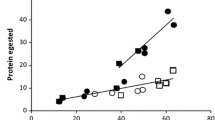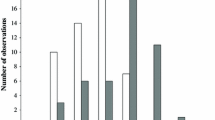Summary
The chaparral shrub Eriodictyon californicum secretes a phenolic leaf resin composed of flavonoid aglycones. We used leaves with artificially altered resin contents to test the effects of resin on the feeding, growth, and oviposition of the specialist herbivore Trirhabda diducta. In addition, we compared Trirhabda feeding and growth on young foliage with that on foliage from the preceding year. Our results show that the Eriodictyon leaf resin affects Trirhabda larvae and adults similarly, having no significant effect on growth rates or on nutrient utilization at up to 5X the resin levels normally encountered by larvae in the field. Both Trirhabda larvae and adults respond to high resin concentrations by increasing their consumption rates, with concomitant decreases in digestibility and the efficiency of conversion of ingested food to biomass. Low-resin foliage is preferred by larvae for feeding and by adults for oviposition. Larvae feeding on leaves of the current season have higher growth efficiencies, consumption, and growth compared to larvae feeding on leaves from the preceding year.
Similar content being viewed by others
References
Bernays EA, Chamberlain DJ, Leather EM (1981) Tolerance of Acridids to ingested condensed tannin. J Chem Ecol 7:247–256
Caldwell MM (1968) Solar ultraviolet radiation as an ecological factor for alpine plants. Ecol Monogr 38:243–268
Essig EO (1936) Insects of western North America. McMillan Co., New York, p 478
Feeny P (1970) Seasonal changes in oak leaf tannins and nutrients as a cause of spring feeding by winter moth caterpillars. Ecology 51:565–581
Fox LR, MacCauley BJ (1977) Insect grazing on Eucalyptus in response to variation in leaf tannins and nitrogen. Oecologia (Berlin) 29:145–162
Gordon HT (1968) Quantitative aspects of insect nutrition. Am Zool 8:131–138
Harley KLS, Thorsteinson AJ (1967) The influence of plant chemicals on the feeding behavior, development, and survival of the two-striped grasshopper, Melanoplus bivittatus (Say), Acrididae Orthoptera. Can J Zool 45:305–319
Johnson ND (1983) Flavonoid aglycones from Eriodictyon californicum resin and their implications for herbivory and UV screening. Biochem Syst Ecol 11:211–215
Johnson ND, Chu CC, Ehrlich PR, Mooney HA (1984) The seasonal dynamics of leaf resin, nitrogen, and herbivore damage in Eriodietyon californicum and their parallels in Diplacus aurantiacus. Oecologia (Berlin) 61:398–402
Lincoln, DE (1980) Leaf resin flavonoids of Diplacus aurantiacus. Biochem Syst Ecol 8:397–400
Lincoln DE, Newton TS, Ehrlich PR (1982) Coevolution of the checkerspot butterfly Euphydryas chalcedona and its larval food plant Diplacus aurantiacus: larval response to protein and leaf resin. Oecologia (Berlin) 52:216–223
Maddrell SHP, Gardiner BOC (1976) Excretion of alkaloids by Malpighian tubules of insects. J Exp Biol 64:267–281
Miller JS, Feeny P (1983) Effects of benzylisoquinoline alkaloids on the larvae of polyphagous Lepidoptera. Oecologia (Berlin) 58:332–339
Mooney HA, Ehrlich PR, Lincoln DE, Williams KS (1980) Environmental controls on the seasonality of a drought-deciduous shrub, Diplacus aurantiacus and its predator, the checkerspot butterfly, Euphydryas chalcedona. Oecologia (Berlin) 45:143–146
Mooney HA, Williams KS, Lincoln DE, Ehrlich PR (1981) Temporal and spatial variability in the interaction between the checkerspot butterfly, Euphydryas chalcedona and its principal food source, the Californian shrub, Diplacus aurantiacus. Oecologia (Berlin) 50:195–198
Rhoades DF (1977) Integrated antiherbivore, antidesiccant and ultraviolet screening properties of creosote bush resin. Biochem Syst Ecol 5:281–290
Schoonhoven LM, Meerman J (1978) Metabolic cost of changes in diet and neutralization of allelochemics. Ent Exp Appl 24:489–493
Schultz JC (1983) Impact of variable plant defensive chemistry on susceptibility of insects to natural enemies. In PA Hedin (ed) Plant resistance to insects. American Chem. Soc., Washington DC pp 37–54
Scriber JM (1979) The effects of sequentially switching food plants upon biomass and nitrogen utilization by polyphagous and stenophagous Papilio larvae. Ent Exp Appl 25:203–215
Scriber JM (1981) Sequential, diets, metabolic costs, and growth of Spodoptera eridania feeding on dill, lima bean, and cabbage. Oecologia (Berlin) 51:175–180
Seigler D, Price PW (1976) Secondary compounds in plants: primary functions. Am Nat 110:101–105
Siegel S (1956) Nonparametric statistics. McGraw-Hill, New York, pp 36–42
Slansky F Jr, Feeny P (1977) Stabilization of the rate of nitrogen accumulation by larvae of the cabbage butterfly on wild and cultivated food plants. Ecol Monogr 47:209–228
Waldbauer GP (1968) The consumption and utilization of food by insects. Adv Insect Physiol 5:229–288
Waller GR, Nowacki EK (1978) Alkaloid biology and metabolism in plants. Plenum Press, New York pp 143–157
Williams KS, Lincoln DE, Ehrlich PR (1983) The coevolution of Euphydryas chalcedona butterflies and their larval host plants. I. Larval feeding behavior and host plant chemistry. Oecologia (Berlin) 56:323–329
Author information
Authors and Affiliations
Rights and permissions
About this article
Cite this article
Johnson, N.D., Brain, S.A. & Ehrlich, P.R. The role of leaf resin in the interaction between Eriodictyon californicum (Hydrophyllaceae) and its herbivore, Trirhabda diducta (Chrysomelidae). Oecologia 66, 106–110 (1985). https://doi.org/10.1007/BF00378560
Received:
Issue Date:
DOI: https://doi.org/10.1007/BF00378560




